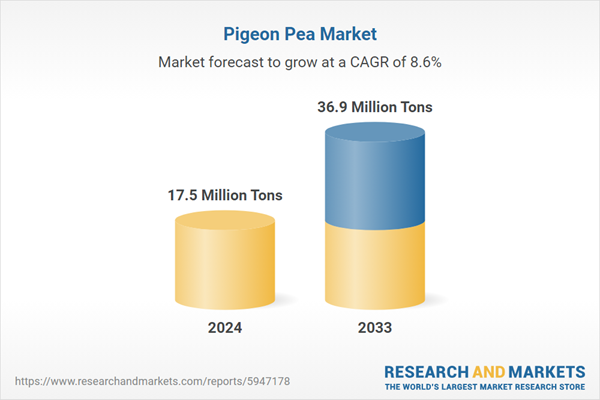Pigeon pea is a tropical plant of the pea family, which is commonly grown as a food crop. It has a deep tap-root structure that enables it to collect water and other nutrients from the secondary soil profile for thriving during dry seasons. It is a rich source of thiamin, riboflavin, niacin, vitamin B-6, folate, vitamin A, calcium, iron, magnesium, phosphorous, and potassium. It helps prevent and cure ailments like bronchitis, coughs, pneumonia, respiratory infections, pain, menstrual disorders, sores, wounds, abdominal tumors, diabetes, acidity, stomach pain, poisoning, piles, and swelling of internal organs. Besides this, as it is an ideal supplement for a protein-deficient diet, the consumption of pigeon pea is rising across the globe.
Pigeon Pea Market Trends
At present, pigeon pea finds extensive applications in animal feed, fuel wood, rearing lac insects, green manuring, soil conservation, and windbreaks. Besides this, it is employed in the food and beverage industry for preparing different soups, stews, curries, sauces, and rice dishes on account of its numerous health benefits. These health benefits include boosting energy, building immunity, preventing anaemia, treating inflammation, maintaining blood pressure, and strengthening the cardiovascular system and digestive systems. Moreover, pigeon pea is considered one of the most pivotal pulse crops for food and feed security in dry places due to its high drought resilience. Apart from this, the perennial nature of pigeon pea enables farmers to take multiple harvests and use the surplus for trade in both local and international markets. This, coupled with the rapidly growing population, low prices, expanding imports, rising per capita income and the easy availability of high storage facilities worldwide, is projected to create a positive outlook for the market in the upcoming years.Market Segmentation
This report provides an analysis of the key trends in each sub-segment of the global pigeon pea market report, along with forecasts at the global and regional level from 2025-2033.Breakup by Region
- India
- Myanmar
- Malawi
- Kenya
- Tanzania
Competitive Landscape
The competitive landscape of the market has been analyzed in the report, along with the detailed profiles of the major players operating in the industry.Key Questions Answered in This Report
1. What was the size of the global pigeon pea market in 2024?2. What is the expected growth rate of the global pigeon pea market during 2025-2033?
3. What are the key factors driving the global pigeon pea market?
4. What has been the impact of COVID-19 on the global pigeon pea market?
5. What are the key regions in the global pigeon pea market?
Table of Contents
Methodology

LOADING...
Table Information
| Report Attribute | Details |
|---|---|
| No. of Pages | 140 |
| Published | February 2025 |
| Forecast Period | 2024 - 2033 |
| Estimated Market Value in 2024 | 17.5 Million Tons |
| Forecasted Market Value by 2033 | 36.9 Million Tons |
| Compound Annual Growth Rate | 8.6% |
| Regions Covered | Global |









